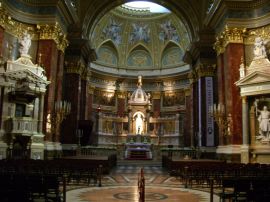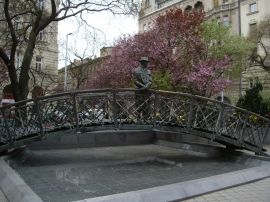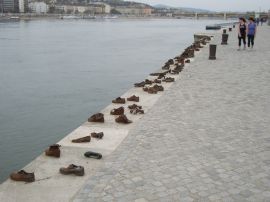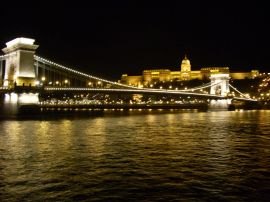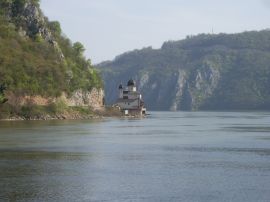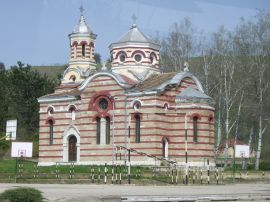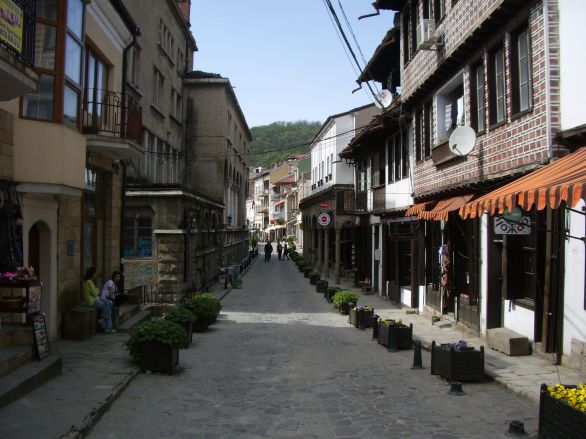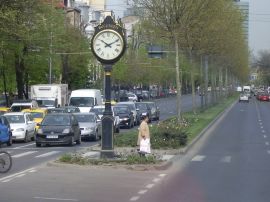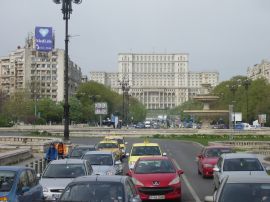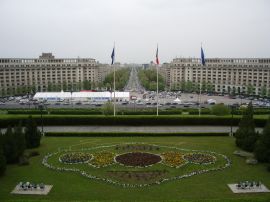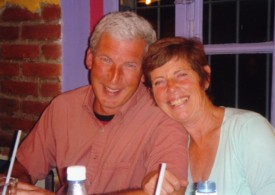April 2016 – River Cruise from Budapest to Bucharest
We have just completed a most wonderful river cruise with Viking River Cruises. We travelled from Budapest through Croatia, Serbia and Bulgaria before landing in Romania and travelling to Bucharest for our flight home. The ship, Viking Vili, was only 15months old and absolutely fantastic. 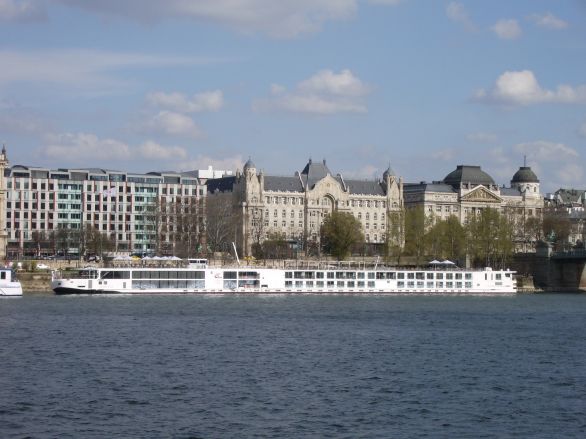 Every part had that brand new feeling about it and our cabin was perfect for us. As there were only about 135 passengers out of a capacity of 190, the ship seemed very spacious. The food on board was really good and as an alternative to the formal dining room there was the Aquavit Terrace. Apart from our first dinner we chose to eat all our meals on the Terrace simply because breakfast was continental and more favourable to the waist line and also lunch and dinner were lighter meals than in the restaurant. Very few ate on the Terrace (we were the only ones one night) and as a result we received personal service from the staff and Terrace chef who very soon was preparing vegetarian food for Annie without being asked. Enough about our wonderful floating hotel, what about the sights.
Every part had that brand new feeling about it and our cabin was perfect for us. As there were only about 135 passengers out of a capacity of 190, the ship seemed very spacious. The food on board was really good and as an alternative to the formal dining room there was the Aquavit Terrace. Apart from our first dinner we chose to eat all our meals on the Terrace simply because breakfast was continental and more favourable to the waist line and also lunch and dinner were lighter meals than in the restaurant. Very few ate on the Terrace (we were the only ones one night) and as a result we received personal service from the staff and Terrace chef who very soon was preparing vegetarian food for Annie without being asked. Enough about our wonderful floating hotel, what about the sights.
We started in Budapest,  originally made up of two towns Buda and Pest separated by the River Danube.
originally made up of two towns Buda and Pest separated by the River Danube.
The old buildings were magnificent including Mathias Church and the Fishermen’s Bastion on the Buda side of the river and the very beautiful Parliament Building on the Pest side.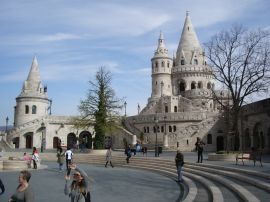
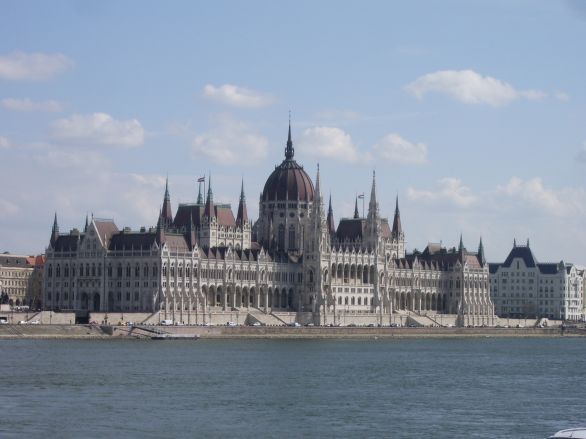
We also found the very beautiful St Stephen’s Basilica and Heroes’ Square was also a magnificent memorial.
On our walks around we came across many small modern statues including this man on a bridge. We also visited the very poignant Shoe Memorial to the Jews murdered by the fascist Arrow Cross militiamen in the Second World War.
We thoroughly enjoyed our short stay in Budapest which will be remembered for its cleanliness, magnificent buildings, memorials and impressive night time views.
The second port of call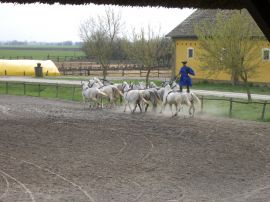 was Kalocsa in Hungary. Amongst other things we were treated to a display of traditional horsemanship. Our next stop was Croatia and the towns of Vukovar and Osijek. We were treated to coffee and home-made cakes in a family home. The house had been destroyed in the Balkan war and the owner was injured in the fighting. The family had, with help from the government rebuilt their home but there were still a lot of damaged buildings in the locality. We were made very welcome and enjoyed a tour of their garden.
was Kalocsa in Hungary. Amongst other things we were treated to a display of traditional horsemanship. Our next stop was Croatia and the towns of Vukovar and Osijek. We were treated to coffee and home-made cakes in a family home. The house had been destroyed in the Balkan war and the owner was injured in the fighting. The family had, with help from the government rebuilt their home but there were still a lot of damaged buildings in the locality. We were made very welcome and enjoyed a tour of their garden.
All too quickly we had moved on to Serbia and the capital Belgrade situated on the confluence of the Rivers Sava and Danube.
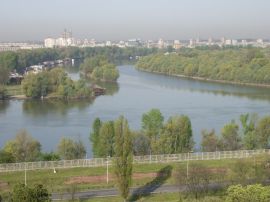
 The city’s location, at the intersection of Eastern and Western Europe, made it a much ‘contested’ region throughout history with the Kalemegdan Fortress. Belgrade’s Cathedral St. Sava has been under construction since 1935 and is still unfinished but is still one of the largest Orthodox Churches in the World.
The city’s location, at the intersection of Eastern and Western Europe, made it a much ‘contested’ region throughout history with the Kalemegdan Fortress. Belgrade’s Cathedral St. Sava has been under construction since 1935 and is still unfinished but is still one of the largest Orthodox Churches in the World.
The whole of the next day 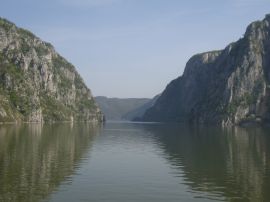 was spent cruising down the Danube to Vidin in Bulgaria.
was spent cruising down the Danube to Vidin in Bulgaria.
The Danube is normally quite wide but on this day we sailed through spectacular narrow gorges known as the Iron Gate.
The scenery was lovely with two memorable sites shown below.
We also passed through two massive locks which was quite an experience.
Vidin itself was a pleasant town with the only entirely preserved medieval Bulgarian Castle! From Vidin we took a bus ride to the spectacular rock formations and fortress at Belogradchik. The rock formations are great natural wonder and are a curiosity for the many fantastic figures and profiles that emerge when you catch them at the right angle. During our journey we passed the quite beautiful small church shown below.
We sailed overnight to the town of Russe from where we took a full day tour to the towns of Veliko Tarnovo and Arbanasi. Arbanasi was a small town with a small church with a rather drab exterior. However, the inside of the Nativity Church was covered with intricate frescoes dating back many centuries. We did not take photographs as flash was prohibited and the place was rather dark. However, we passed the beautiful Judas tree on our walk from the church to a restaurant.
to the town of Russe from where we took a full day tour to the towns of Veliko Tarnovo and Arbanasi. Arbanasi was a small town with a small church with a rather drab exterior. However, the inside of the Nativity Church was covered with intricate frescoes dating back many centuries. We did not take photographs as flash was prohibited and the place was rather dark. However, we passed the beautiful Judas tree on our walk from the church to a restaurant.
Veliko Tarnovo was a town Gerry had visited during his working trip to Bulgaria in 1998. We even had coffee in the hotel where he stayed. An ex communist hotel it was still pretty awful and in need of quite a lot of attention.

 However, the rest of the town was very pleasant if not beautiful and we enjoyed a trip to Tsarevets Hill with a hilltop Royal Palace and then along a street full of artisans’ shops and workshops.
However, the rest of the town was very pleasant if not beautiful and we enjoyed a trip to Tsarevets Hill with a hilltop Royal Palace and then along a street full of artisans’ shops and workshops.
We fell in love with a large hand thrown and decorated bowl bought it and then wondered how on earth we would get it home to the UK in one piece (we managed).
Our final port of call was Giurgiu in Romania although we saw little of the town as we headed straight to Bucharest by coach. Bucharest was a city of contrast, there were the ‘Commie Condos’ the name given to the drab concrete apartments the communists constructed so workers could be near the factories they had erected. They are depressing to look at, let alone live in. They were very small and very poorly insulated. The ones that had been renovated looked really good but the others were depressing. On the other hand the buildings from the late 19th and early 20th centuries that Ceauscau had not destroyed were magnificent. The roads were frequently wide dual carriageways with grass reservations. We visited a Village Museum but many of the historic buildings (relocated from all regions of the country) were locked and there was little to tell us the detail of what we were looking at (disappointing as the place had tremendous tourist potential).
Our final visit was to the second largest building, by volume, in the world – Ceauscau’s Palace of Parliament with 3000 rooms and gold ceilings. We enjoyed a tour of part of the building which is now used as the parliament and a conference centre. Apparently it is about 70% utilised. The view from the balcony was quite spectacular – a bit like the balcony at Buckingham Palace that overlooks the Mall.
And so our passage to Eastern Europe came to an end. We certainly enjoyed ourselves and adapted well to the concept of a floating hotel. Who knows we may do more River Cruises in the future.


